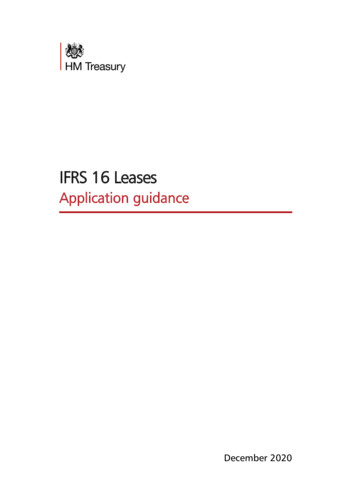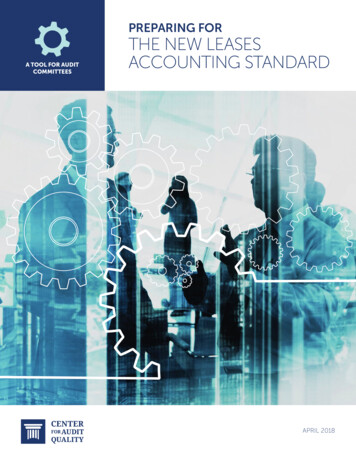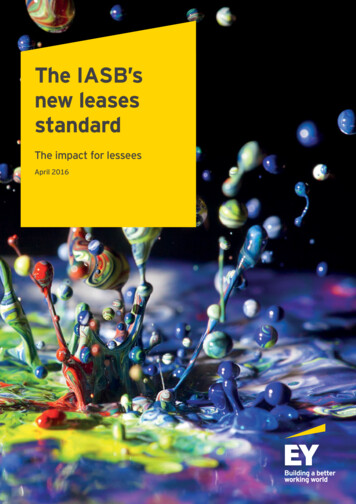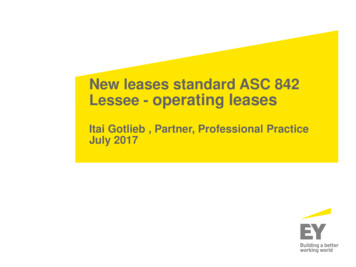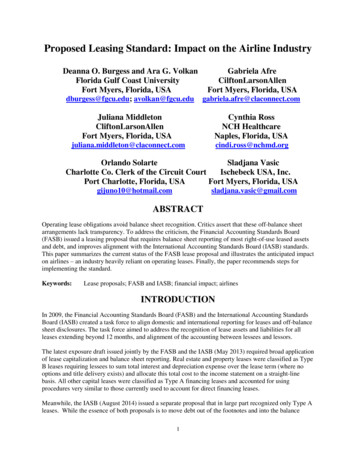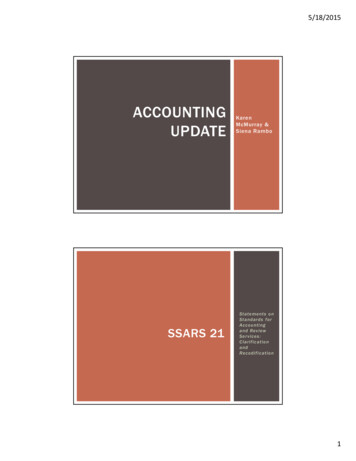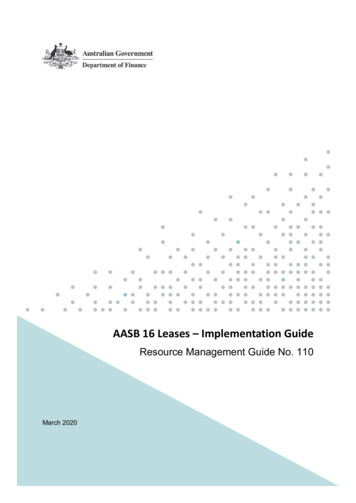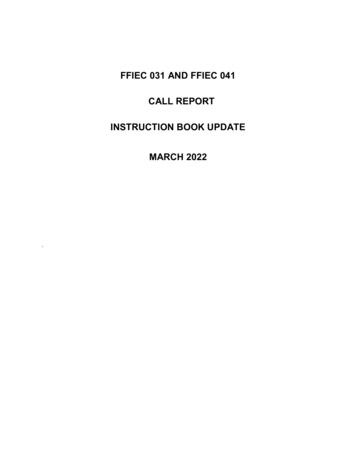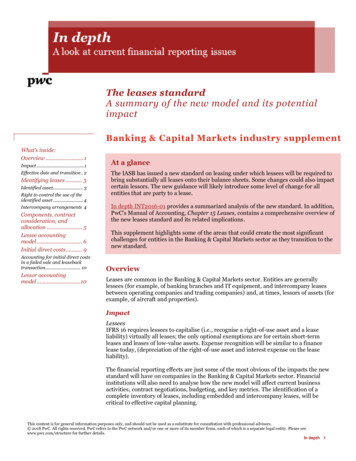
Transcription
The leases standardA summary of the new model and its potentialimpactBanking & Capital Markets industry supplementWhat’s inside:Overview . 1Impact . 1Effective date and transition . 2Identifying leases . 3Identified asset. 3Right to control the use of theidentified asset . 4Intercompany arrangements 4Components, contractconsideration, andallocation . 5Lessee accountingmodel . 6Initial direct costs . 9Accounting for initial direct costsin a failed sale and leasebacktransaction. 10Lessor accountingmodel .10At a glanceThe IASB has issued a new standard on leasing under which lessees will be required tobring substantially all leases onto their balance sheets. Some changes could also impactcertain lessors. The new guidance will likely introduce some level of change for allentities that are party to a lease.In depth INT2016-01 provides a summarized analysis of the new standard. In addition,PwC’s Manual of Accounting, Chapter 15 Leases, contains a comprehensive overview ofthe new leases standard and its related implications.This supplement highlights some of the areas that could create the most significantchallenges for entities in the Banking & Capital Markets sector as they transition to thenew standard.OverviewLeases are common in the Banking & Capital Markets sector. Entities are generallylessees (for example, of banking branches and IT equipment, and intercompany leasesbetween operating companies and trading companies) and, at times, lessors of assets (forexample, of aircraft and properties).ImpactLesseesIFRS 16 requires lessees to capitalise (i.e., recognise a right-of-use asset and a leaseliability) virtually all leases; the only optional exemptions are for certain short-termleases and leases of low-value assets. Expense recognition will be similar to a financelease today, (depreciation of the right-of-use asset and interest expense on the leaseliability).The financial reporting effects are just some of the most obvious of the impacts the newstandard will have on companies in the Banking & Capital Markets sector. Financialinstitutions will also need to analyse how the new model will affect current businessactivities, contract negotiations, budgeting, and key metrics. The identification of acomplete inventory of leases, including embedded and intercompany leases, will becritical to effective capital planning.This content is for general information purposes only, and should not be used as a substitute for consultation with professional advisors. 2018 PwC. All rights reserved. PwC refers to the PwC network and/or one or more of its member firms, each of which is a separate legal entity. Please seewww.pwc.com/structure for further details.In depth 1
On April 6, 2017, the Basel Committee on Banking Supervision issued a “frequentlyasked questions” press release related to lease accounting. The FAQ made it clear thatright-of-use assets related to underlying tangible assets should not be deducted fromRegulatory capital. They are not akin to intangible assets and should be included in riskbased capital and leverage denominators at 100% risk weighting, similar to the treatmentfor tangible assets.For regulated banking institutions, the recognition of right-of-use assets on the balancesheet may impact the calculation of regulatory capital ratios by increasing the assets inthe denominator of the risk-based capital ratios (risk-weighted assets) and leveragecapital ratio (adjusted asset). All other things being equal, a higher denominator willresult in lower capital ratios for the financial institution.Financial institutions with a large portfolio of leases will need to evaluate their ability togather the required information on existing leases, which will be critical to an orderlytransition to the new standard. This may result in the need for new systems, controls,and processes, which will take time to identify, design, implement, and test.LessorsThe accounting model for lessors remains broadly consistent with existing IFRS, aslessors will classify leases as operating or financing based on the same guidance that is inIAS 17 today. To the extent that financial institutions have arrangements with customerswhich contain lease and non-lease components, the lessor will need to consider theinteraction of IFRS 16 with IFRS 15, which may result in certain components of thearrangement being accounted for as other revenue rather than as part of the lease.The new rules may impact the financial metrics of customers and borrowers, causingsome to re-evaluate whether to buy an asset instead of leasing it or to reconsider certainterms of a lease. For example, when underwriting new loans, bank personnel will need tounderstand the impact of the new accounting on the financial statements of potentialborrowers, and will need to understand the impact the standard may have on howlending covenants have been traditionally structured.Effective date and transitionThe effective date is for annual reporting periods beginning on or after 1 January 2019.Early adoption is permitted for all entities as long as they have already adopted IFRS 15.IFRS 16 has also been endorsed for use in the European Union.The new standard permits two transition methods. Acknowledging the potentiallysignificant impact of the new lease standard on a lessee’s financial statements, IFRS 16does not require a full retrospective application in accordance with IAS 8 but allows a‘simplified approach’. Full retrospective application is optional. If a lessee elects the‘simplified approach’, it does not restate comparative information. Instead, thecumulative effect of applying the standard is recognised as an adjustment to the openingbalance of retained earnings (or other component of equity, as appropriate) at the date ofinitial application. In addition, there are a number of practical expedients.In depth2
Identifying leasesRegardless of how an arrangement is structured, the lease accounting guidance in IFRS 16 applies to any arrangementthat conveys control over an identified asset to another party. The arrangement or agreement does not need to be calleda lease or be a lease in its entirety. An arrangement is a lease or contains a lease if (1) there is an explicitly or implicitlyidentified asset and (2) use of the asset is controlled by the customer (user of the asset or taker of the output from theasset).Identified assetAn identified asset can be specified explicitly (e.g. a computer, by its serial number) or implicitly. However, in all cases,the asset is not identified if the supplier has a substantive contractual right to substitute such asset (e.g., if the serverprovider can substitute the server available to the bank). A substitution right is substantive if the supplier can (a)practically use another asset to fulfil the arrangement throughout the term of the arrangement and (b) it is economicallybeneficial for the supplier to do so. The supplier’s right or obligation to substitute an asset for repairs, maintenance,malfunction, or technical upgrade does not preclude the asset from being considered an identified asset.An identified asset must be physically distinct. A physically distinct asset may be an entire asset or a portion of an asset.For example, a building is generally considered physically distinct, but one floor within the building may also beconsidered physically distinct if it can be used independent of the other floors (e.g., point of entry or exit, access tolavatories). However, a capacity or other portion of an asset is an identified asset if (1) it is not physically distinct (e.g.,an arrangement permits use of a portion of the capacity of a server); and (2) the customer does not have the right tosubstantially all of the economic benefits from the use of the asset (e.g., even though several parties share the use of theserver, no customer has substantially all of the capacity).Example 1 –Whether a contract contains a lease: outsourced information technology functionFacts: Commercial Bank (“Customer”) enters into a 3-year IT contract with a service provider (“Supplier”) for IT relatedservices. Under this arrangement, Supplier installs a dedicated server at Customer’s premises to be used by Customerduring the term of the arrangement. The server is explicitly identified in the contract and Supplier is permitted tosubstitute the server only if it malfunctions. Customer decides which data to store on or delete from the server and howto integrate the server within its operations throughout the contract term. Supplier provides maintenance and othersupport services, such as nightly data back-up and software upgrades. The Supplier does not have any right to decidethe deployment of the server during the term of the arrangement (it cannot make any decisions about the use of theserver during the period of use, it does not have the right to decide how data is transported using the server, it cannotdecide whether to reconfigure the server and it cannot decide whether to use the server for another purpose).In depth3
Question: Does the contract contain an identified asset?Discussion: Based on the facts in this example, the contract contains a lease.The contract explicitly identifies a server that Supplier can substitute only in the event of malfunction. Therefore, thearrangement contains identified property, plant, or equipment, i.e., the server. Since the contract has an identifiedasset, it is now necessary to determine who controls the use of that identified asset to determine whether thearrangement contains a lease.Right to control the use of the identified assetA customer controls the use of the identified asset by possessing (1) the right to obtain substantially all of the economicbenefits (e.g., output) from the asset (“economics”) and (2) the right to direct the use of the identified asset throughoutthe period of the arrangement (“power”). The economics criterion may sound similar to today’s model under which anarrangement is deemed to meet the economics criterion if it is remote that any other party will take more than a minoramount of the output. However, under current guidance, if the customer has the right to substantially all of the output,there is a pricing exception that precludes the economics criterion from being met. That is, under current guidance,having substantially all of the output is not enough to satisfy the criterion if the price that the customer will pay for theoutput is either contractually fixed per unit or equal to the current market price per unit at the time of delivery.A customer meets the “power” criterion if it holds the right to make decisions that have the most significant impact onthe economic benefits derived from the use of the asset. In some cases, the use of the asset is predetermined in thecontract (e.g., a piece of equipment). If decisions that have the most impact on the economic benefits to be derived fromthe use of the underlying asset are pre-determined, the customer may still have control if either (a) the customer has theright to direct the operations of the asset without the supplier having the right to change those operating instructions or(b) the customer has designed the asset (or specific aspects of the asset) in a manner that predetermines how and forwhat purpose the asset will be used. Sometimes there may be terms in the contract that are protective in nature that areincluded to protect the supplier’s asset and supplier’s personnel and comply with regulations. For example, a contractmay restrict usage of a piece of equipment up to a maximum number of hours per period based on the piece ofequipment’s design constraints. The existence of such protective rights in and of itself does not prevent a customer fromhaving the right to direct the use of an asset.In the context of Example 1 above, the Customer has the right to control the use of the server because it has (a) the rightto obtain all of the economic benefits from the use of the identified server based on its exclusive access and use of theserver during the 3-year term; and (b) the right to direct the use of the identified server because of its ability todetermine which data is stored, and the nature and timing of the content placed on the server. Maintenance andsupport activities ensure the server operates as it should, but do not impact how and for what purpose the server is usedbecause they do not affect the economic benefits derived from use of the server.PwC observation:Financial institutions may have data for leases related to their Head Office and branch networks but ensuring acomplete inventory of leases will mean evaluating all types of arrangements for embedded leases. For example, therehas been a trend for many financial institutions to outsource business operations and support functions such as IT—insome cases on a global scale—to leverage and drive expertise. Financial institutions will need to assess suchcontractual arrangements to determine if they contain embedded leases. Common examples of arrangements thatmight contain an embedded lease are the outsourcing of data centres and hosting arrangements. Banks may also haveleases associated with their ATMs or other assets. Arrangements that are considered to be leases may or may notqualify for the exemption available for short-term leases.Intercompany arrangementsIntercompany arrangements designed to allocate overhead and other costs, such as rent, to different business and legalentities are common in the financial services sector. Companies will need to analyse such arrangements to determine ifthey are leases or contain embedded leases. While these types of arrangements exist in many industries, the impact ofthe new leases standard may be significant to financial services companies because they tend to have a large number ofsubsidiaries and legal entities through which they conduct business that prepare standalone financial statements.In depth4
While intercompany leases would be eliminated for the purposes of consolidated reporting, some legal entities may berequired to prepare standalone financial statements. The recording of a right-of-use asset and a lease liability in thestandalone financial statements upon application of the new lease accounting model may impact a number of regulatoryreporting and capital calculations for such entities.Under the new leases standard, a lessee may, by class of underlying asset, elect to not reflect a right-of-use asset and alease liability on the lessee’s balance sheet for leases with a term of 12 months or less (“short-term exemption”). Thestandard also stipulates that leases between related parties should be accounted for based on the enforceable terms andconditions of the lease.It is common for an entity to enter into an agreement with its parent company or another member of the consolidatedgroup under which the entity pays a fee in return for the use of space (e.g., a floor in the building), equipment, and otherservices, such as maintenance. These types of agreements may contain a lease. However, if the legally-enforceable termof such agreement is 12 months or less, the lessee entity could elect the short-term exemption and not reflect a right-ofuse asset and a lease liability on its balance sheet.Interpretation of “legally enforceable”The question that arises is how “legally enforceable” should be interpreted in connection with related-partyleases. Some related-party transactions may not be documented and/or the terms and conditions are not at arm’slength. Therefore, in order to operationalise the short-term exemption, we believe a lessee should first focus on what thelegally-enforceable lease term is based on the written agreement. However, if the economics of the written agreementdo not align with the economics of other related transactions (e.g., the lease term is one year but the lessee is installingexpensive leasehold improvements that have an economic life of greater than one year) or there is no writtenagreement, the lessee should determine if there is a binding oral agreement or understanding. The lessee may need tosolicit input from legal counsel about whether the terms and conditions of the oral agreement or understanding arelegally enforceable.PwC observation:Even though a lessee may, by class of underlying asset, elect to not reflect a right-of-use asset and a lease liability onits balance sheet for leases with a term of 12 months or less, entities are still subject to the disclosure requirements forrelated-party transactions under IAS 24, Related Party Disclosures. This includes disclosing information necessary tounderstand the effects of the related-party transactions on the entity’s financial statements, such as a description ofthe relationships and the transactions.Components, contract consideration, and allocationAn arrangement may contain lease and non-lease components. Components are those items or activities in thearrangement that transfer a good or service to a customer/lessee (e.g. maintenance of bank branches provided bylandlord of the shopping centre which the branch is located within). A right to use an underlying asset is a separatelease component from other lease components if (a) the lessee can benefit from the right-of-use either on its own ortogether with other resources that are readily available to the lessee, and (b) the right-of-use is neither highly dependenton nor highly interrelated with the other rights to use underlying assets in the contract.Non-lease components are subject to other GAAP outside of the new leases standard (for example, non-leasecomponents may be lessor performance obligations under the new revenue standard). Property taxes and insurancethat do not represent separate goods or services are not components. Any fixed payments by the lessee for these itemsare considered part of overall contract consideration to be allocated among the lease and non-lease components.Maintenance costs, on the other hand, involve delivery of a separate service, and are therefore considered a non-leasecomponent if provided by the lessor to the lessee. In leases containing land, the land is a separate lease componentunless the accounting effect of separately accounting for the land component is insignificant (for example, the amountrecognized for the land lease component would be insignificant or separating the land lease component would notimpact the lease classification of any lease component).In depth5
Once the lease and non-lease components are identified, contract consideration is allocated to each component.A lessee should allocate the contract consideration to each lease and non-lease component based on its relativestandalone price. Any variable payments that are not based on a rate or an index are excluded from the calculation ofthe overall contract consideration. The standard provides a practical expedient under which a lessee may, as anaccounting policy election by class of underlying asset, choose to not separate non-lease components from theassociated lease component and instead account for them all together as part of the applicable lease component.The impact of property taxes and insurance paid by the lessee depends on whether they are fixed or variable. If a lesseepays the actual amount of property taxes and insurance that are not in substance fixed and the payments are not basedon an index or a rate, they should be accounted for similar to other variable lease payments—i.e., excluded fromcontract consideration and excluded from lease payments used for classification and initial measurement—by both thelessee and the lessor. On the other hand, if a lessee pays a fixed amount of property taxes and insurance as part of rentpayments, such payments should be included in contract consideration and allocated to the lease and non-leasecomponents by the lessee and lessor. The effect of doing so, consistent with the notion that property taxes andinsurance are not separate goods that are transferred, is that such payments are subject to allocation to the componentsand the amounts allocated to the lease component are included in the classification and measurement of the lease.Lessor accounting is discussed on page 10.Lessee accounting modelLessees will be required to recognise a right-of-use asset and liability for virtually all of their leases (other than shortterm leases or leases of low value assets). For income statement purposes, leases will produce a front-loaded expensepattern (similar to current finance leases), where a higher interest expense is recognised in earlier reporting periods.Depreciation of the right-of-use asset is on a straight line basis (similar to current finance lease expense recognition).Example 2 – Lessee accounting - initial and subsequent measurementFacts: Commercial Bank enters into a lease of equipment with Lessor Corp. The following is a summary of informationabout the lease and the leased asset.Lease commencement dateJanuary 1, 20x1Lease term5 years with no renewal optionRemaining economic life of the equipment6 yearsPurchase optionNoneAnnual lease payments 525,000Payment dateAnnually in advance on January 1 (first lease payment isdue on lease commencement date)Fair value of the equipment at lease commencement date 2,500,000Commercial Bank’s incremental borrowing rate5%Residual value guaranteeNoneInitial direct costsNoneOther informationIn depth6
The interest rate implicit in the lease that Lessor Corp charges Commercial Bank is not readily determinableby Commercial Bank Title to the equipment remains with Lessor Corp throughout the period of the lease and upon leaseexpiration Commercial Bank does not guarantee the residual value of the equipment Commercial Bank pays for insurance and maintenance of the equipment separate from lease payments The lease commencement date does not fall at or near the end of the economic life of the equipment The right-of-use asset is not impairedQuestion 1: How should Commercial Bank account for the lease at lease commencement date?Discussion: Commercial Bank should measure the lease liability by calculating the present value of the unpaid annualfixed lease payments of 525,000 discounted at Commercial Bank’s incremental borrowing rate of 5% ( 1,861,625). Theright-of-use asset would be equal to the lease liability, plus 525,000 rent paid on lease commencement date( 2,386,625).Although not included in the example, the right-of-use asset would be reduced by any lease incentives received fromCommercial Bank on or before the lease commencement date and increased by initial direct costs incurred byCommercial Bank or lease payments made to Lessor Corp before the commencement date.Question 2: How should Commercial Bank subsequently measure the right-of-use asset and lease liability during thelease term?Discussion: Commercial Bank would subsequently account for the lease liability and right-of-use asset as follows. Theright-of-use asset would be amortized on a straight-line basis over the lease term because the remaining economic life ofthe leased equipment is greater than the lease term consistent with the principles in IAS 16, Property, Plant on 1,861,625Right-ofuse asset 525,000*** 525,000 2,386,625Year 1 525,000 431,919 93,081 1,429,706Year 2 525,000 453,515 71,485 976,191 477,325 1,431,975Year 3 525,000 476,190 48,810 500,001 477,325 954,650Year 4 525,000 500,001 24,999 - 477,325 477,325Year 5 - - - - 477,325 - 2,625,000 1,861,625 238,375 - 2,386,625 - 477,325 1,909,300* This would be classified as a financing outflow on the statement of cash flows.** This would be classified as an operating or financing outflow on the statement of cash flow.*** Initial payment was due at lease commencement date; therefore, the entire payment is a reduction of principal.In depth7
PwC observation:The incremental borrowing rate is the rate of interest that a lessee would have to pay to borrow, over a similar termand with a similar security, the funds necessary to obtain an asset of a similar value to the right-of-use asset in asimilar economic environment. When calculating the incremental borrowing rate, a lessee should consider thefollowing:- The rate calculated should be the rate at which the entity could borrow. The rate should not reflect the cost of equityfinance and, as such, it would be inappropriate to use a WACC (or any other rate including a component ‘cost ofcapital’ alongside the cost of debt). Similarly, it would be inappropriate to use a transfer pricing rate (used for taxtransfer pricing adjustments) because these are typically ‘risk-free’. However, there might be scenarios in which theserates can be used as a starting point, provided that appropriate adjustments are made.- The rate should reflect the amount that the entity could borrow over the term of the lease. It should be the rate atwhich an entity would borrow to acquire an asset of similar value to the right-of-use asset, rather than to acquire theentire underlying asset. An exception would be where the lease term is for substantially all of the life of the underlyingasset.- The rate should reflect that of a secured borrowing for a similar asset (being the right-of-use asset, not theunderlying asset), rather than an unsecured borrowing or general line of credit.- The rate should reflect the credit standing of the entity and the rate at which it would borrow in a similar economicenvironment. For example, if a company has GBP functional currency and typically borrows in GBP, but it enters intoa US dollar lease, the incremental borrowing rate will reflect the cost of borrowing US dollars.Example 3 – Lease of space for installation of ATMsFacts: Commercial Bank has automated teller machines (ATMs) for purposes of providing a self-service option to itsdepositors and customers. While Commercial Bank places many of its ATMs at its branches, it also enters into leaseswith third parties to place its ATMs in shopping centres and other strategic locations. The ATMs are built securely intothe premises. The leases for space often have a non-cancellable term of 12 months with a 1-year renewal option. Therent during the renewal period would be the market rent at the time of exercise of the renewal option by CommercialBank. Commercial Bank has exercised its renewal option for a majority of such leases in the past.Question: How should Commercial Bank determine the lease term?Discussion: In IFRS 16, a lessee may elect to not apply the recognition requirements of the standard to short-termleases (i.e., a lease that, at the commencement date, has a lease term of 12 months or less). This election should be madeby class of underlying asset. If a lessee elects this short-term lease exemption, it should recognize the lease payments innet income on a straight-line basis over the lease term along with appropriate disclosures.In evaluating whether or not the lease would be considered short term, at lease commencement date, Commercial Bankshould consider the factors that create an economic incentive for exercise of the renewal option, including contract,asset, entity, or market-based factors. Commercial Bank should compare the renewal rents with the expected marketrents for equivalent property under similar terms and conditions. In general, a renewal option with renewal rents thatare equal to or greater than the rents in the initial lease term is not considered to be reasonably certain of exercise;however, this presumption could be overcome if the economic penalties the lessee would suffer by not exercising therenewal option are significant. For example, if Commercial Bank determines that there would be significant economiclosses incurred if a lease is not renewed, such as the costs to relocate the ATM to another location (since it would becostly to uninstall a built-in ATM and re-install it another location) or lost economic benefits due to losing a strategicATM location, Commercial Bank may conclude that exercise of the renewal option is reasonably certain. Although notdeterminative in isolation, the historical pattern of renewing its leases may indicate that there are factors that wouldcommercially compel Commercial Bank to renew the lease.If Commercial Bank is reasonably certain to exercise the renewal option, then the lease term is 24 months (the initiallease term plus the 1-year renewal option term) and consequently the exemption for short-term leases cannot beapplied.PwC observation:Short-term leases are leases with a lease term of 12 months or less. The lease term also includes periods covered by anoption to extend, or an option to terminate, if the lessee is reasonably certain to exercise the extension option, or notIn depth8
to exercise the termination option. A lease that contains a purchase option is not a short-term lease. The exemptionfor short-term leases must be applied by class of underlying asset.Example 4 – Lease of computers and photocopiersFacts: Commercial Bank leases desktop and laptop computers from IQ Technologies for a period of three years, for staffto use in the Head Office and branches. The desktop computers have an average value of 1,500 and the laptopcomputers have an average value of 2,000.IQ Technologies also leases photocopier machines for a period of 5 years to Commercial Bank which are also used in theHead Office. The photocopiers have an average value of 800. The photocopiers which also have in-built fax machineshave an average value of 1,000.Question: Can Commercial Bank apply the low-value exemption to these leases?Discussion: The analysis of low-value leases does not require the lessee to determine whether low-value assets inaggregate are material
example, of aircraft and properties). Impact Lessees IFRS 16 requires lessees to capitalise (i.e., recognise a right-of-use asset and a lease liability) virtually all leases; the only optional exemptions are for certain short-term leases and leases of low-value assets. Expense recognition will be similar to a finance


